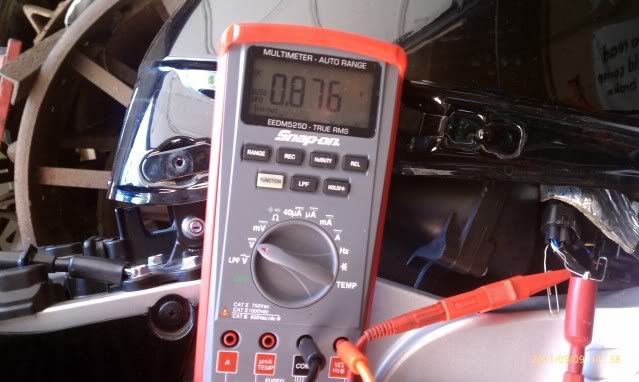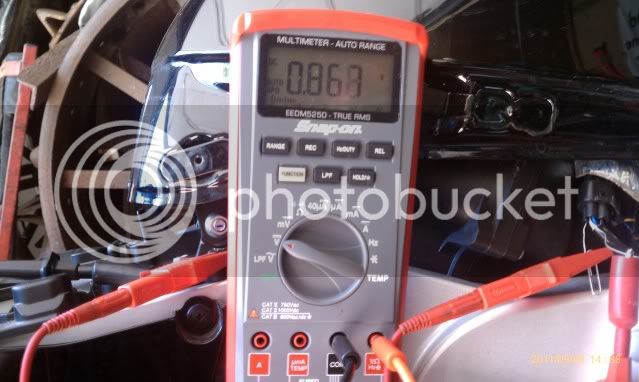RossKean
Well-known member
As documented in "Problems" Click , I recently had a major difficulty with bike operation when a wire from the O2 sensor was inadvertently pinched between the oil pump cover and the engine case. The white wire was apparently at least partly shorted and resulted in VERY rich running, gutless below 2000 rpm and a very thirsty engine. Wire repaired and the operation immediately returned to normal. It has been mentioned that the FJR will run OK with the O2 sensor disconnected but my situation was that the sensor was connected but provided an erroneous reading which was obviously way off. Questions:
1) How would a mis-calibrated O2 sensor affect operation and fuel economy?
2) Is there an easy way to test the O2 sensor for proper function? I have to wonder whether the unexplained significant differences I have seen in terms of fuel consumption between FJR's riding together may be a function of O2 sensor accuracy/calibration. Might be interesting to compare measured AFR.
Is the instrument cluster of the USA Gen II bike REALLY metric? I have been trying to find out whether there was any way to switch the operation of the LCD display from US to Metric. Yamaha doesn't seem to mention any way (eprom swap, dip switches or jumpers) to switch to metric but they will sell me a metric one for $1000+. I can't imagine that there is a completely different design for the US cluster. A couple of interesting observations...
1) Keep an eye on the temperature display. When the temperature is right on an exact Celcius temperature (i.e. 68 °F = 20 °C) and the temperature is slowly increasing, the °F will spend almost no time at 69 but skip to the nearest °F value corresponding to 21 °C (70 °F). Much less noticible at "in-between" temperatures.
2) Next time you reset the average MPG meter, reset the trip odometer at the same time. Keep an eye on the mileage where the avg mpg updates. You will find that it is at the mile equivalent of 1.0 km intervals.
What's the point - nothing really. Seems that Yamaha has a metric instrument cluster that has some sort of additional function to translate into miles/gallons. Would be nice to be able to eliminate this or at least be able to switch back and forth.
My bike is a US vehicle, purchased from the original owner who bought it from a dealer in Connecticut. Imagine my surprise when I discovered (during a CCT change) that it is actually a California bike as evidenced by the charcoal cannister and associated plumbing in the lower front fairing. It seems that surplus bikes destined for California are commonly shipped to out-of-state dealers. Quick way to tell what you have - there is an extra hose coming out in the front of the bike and at the bottom, there are three screws rather than one holding the two sides together (two of the screws secure the canister bracket to the fairing). Again, no real point to this other than to warn people to make sure they understand what they have before they remove the side fairings for maintenance work. After doing the wrong way when we did the CCT, I discovered that side fairing removal is best accomplished by only removing the left canister bolt from the bottom of the fairing, taking off the left side and simply disconnecting the extra hoses. Leave the canister attached! MUCH easier than the way we did it! Anybody know if there are any other differences in the Cali bike other than the canister and associated plumbing? Has anyone heard of problems associated with the canister - plugging, corrosion etc.?
By the way, if you ever have to replace the California "stuff", be prepared to PAY. The bracket retails at over $500 and the canister is around $270!! With all of the other pieces, the non-discounted cost is close to $1000. Fairings are slightly different with extra holes for the hose and canister bolts.
Ross
1) How would a mis-calibrated O2 sensor affect operation and fuel economy?
2) Is there an easy way to test the O2 sensor for proper function? I have to wonder whether the unexplained significant differences I have seen in terms of fuel consumption between FJR's riding together may be a function of O2 sensor accuracy/calibration. Might be interesting to compare measured AFR.
Is the instrument cluster of the USA Gen II bike REALLY metric? I have been trying to find out whether there was any way to switch the operation of the LCD display from US to Metric. Yamaha doesn't seem to mention any way (eprom swap, dip switches or jumpers) to switch to metric but they will sell me a metric one for $1000+. I can't imagine that there is a completely different design for the US cluster. A couple of interesting observations...
1) Keep an eye on the temperature display. When the temperature is right on an exact Celcius temperature (i.e. 68 °F = 20 °C) and the temperature is slowly increasing, the °F will spend almost no time at 69 but skip to the nearest °F value corresponding to 21 °C (70 °F). Much less noticible at "in-between" temperatures.
2) Next time you reset the average MPG meter, reset the trip odometer at the same time. Keep an eye on the mileage where the avg mpg updates. You will find that it is at the mile equivalent of 1.0 km intervals.
What's the point - nothing really. Seems that Yamaha has a metric instrument cluster that has some sort of additional function to translate into miles/gallons. Would be nice to be able to eliminate this or at least be able to switch back and forth.
My bike is a US vehicle, purchased from the original owner who bought it from a dealer in Connecticut. Imagine my surprise when I discovered (during a CCT change) that it is actually a California bike as evidenced by the charcoal cannister and associated plumbing in the lower front fairing. It seems that surplus bikes destined for California are commonly shipped to out-of-state dealers. Quick way to tell what you have - there is an extra hose coming out in the front of the bike and at the bottom, there are three screws rather than one holding the two sides together (two of the screws secure the canister bracket to the fairing). Again, no real point to this other than to warn people to make sure they understand what they have before they remove the side fairings for maintenance work. After doing the wrong way when we did the CCT, I discovered that side fairing removal is best accomplished by only removing the left canister bolt from the bottom of the fairing, taking off the left side and simply disconnecting the extra hoses. Leave the canister attached! MUCH easier than the way we did it! Anybody know if there are any other differences in the Cali bike other than the canister and associated plumbing? Has anyone heard of problems associated with the canister - plugging, corrosion etc.?
By the way, if you ever have to replace the California "stuff", be prepared to PAY. The bracket retails at over $500 and the canister is around $270!! With all of the other pieces, the non-discounted cost is close to $1000. Fairings are slightly different with extra holes for the hose and canister bolts.
Ross
Last edited by a moderator:























































